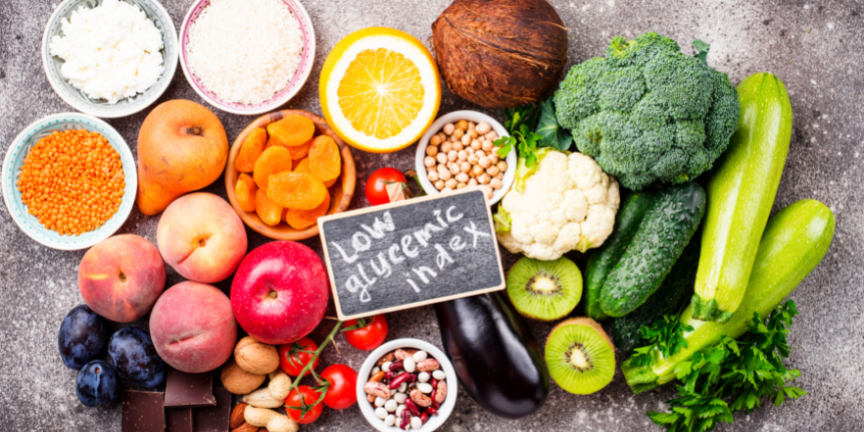Low glycaemic index diet – what is it

Until recently, it was thought that a low glycaemic index diet was only for diabetics. Well, it isn’t. Balanced meals will help you lose weight and improve your wellbeing. What does it involve? What should you eat on a diet? We answer these and other questions!
Low glycaemic index diet – the rules
The glycaemic index (GI) measures the increase in blood glucose concentration after eating a product containing 50 g of carbohydrates compared with the increase after eating 50 g of pure glucose. It therefore refers to foods that are sources of carbohydrates. According to this indicator, foods can be divided into 3 groups: low (GI < 55), medium GI (55-70) and high glycaemic index (GI > 70).
The glycaemic load (GI) is also an important indicator. It takes into account not only the GI of a product, but also the amount of carbohydrates consumed per portion. Importantly, the GI is also influenced by how the food is prepared. As a general rule, the longer a food is cooked, the faster the sugars in it will be digested and absorbed, resulting in a higher GI. In the case of fruit, the riper the fruit, the higher the GI.
So, the general rule of thumb for this diet is to only eat products that have a low glycaemic index, i.e. those with a GI < 55.
Low glycaemic index diet – effects
A properly composed low glycaemic index diet can help you lose a few pounds and improve your health. However, in this case, you must not only follow the GI ratios, but also remember to keep your meals calorie-conscious. The fact that products with a low glycaemic index take longer for the body to digest means that you will feel hungry much later. So you don’t have the need to snack between meals. In addition, the diet calls for low-processed foods, so you take care of the ecology and eat healthily at the same time.
Some studies also suggest that this type of diet may have much more serious benefits for your health. It is likely to lower your cholesterol levels and reduce the risk of certain types of cancer and heart disease. There is no doubt that, in addition to this, the diet protects against the development of diabetes and insulin resistance.
What has a low glycaemic index?
If you want to start a low glycaemic index diet, you need to know which products are advisable and which are better avoided.
Products with a low glycaemic index
A low-glycaemic diet should mainly contain natural, unprocessed products without added sugars. In this group are, among others:
- fruits: apples, strawberries, raspberries, blueberries, avocados, currants, grapefruit and apricots;
- vegetables: tomatoes, courgettes, onions, garlic, cauliflower, broccoli, olives, cucumbers, and those rich in starch: sweet potatoes with orange flesh, maize;
- dairy products and their vegetable substitutes: eggs, milk, cheese, yoghurt, coconut milk, soya milk, almond milk;
- fish and seafood: salmon, trout, tuna, sardines and prawns;
- meat: beef, chicken, pork, lamb;
- fats and oils: olive oil and butter;
- nuts: almonds, cashew nuts, pistachios, walnuts and macadamia nuts;
- cereals: basmati, long grain and brown rice; quinoa, barley, pearl couscous, buckwheat, semolina;
- pasta: classic, vermicelli and rice;
- bread: wholemeal, multigrain, rye, sourdough.

What to avoid on a low glycaemic index diet?
If you have to stick to your diet and prepare dishes composed of ingredients that have a low glycaemic index, you should avoid products such as:
- bread: white bread and rolls, bagels, naan breads, Turkish bread, French baguettes, Lebanese bread;
- breakfast cereals: instant oats, rice crackers, cornflakes;
- starchy vegetables: potatoes, instant mashed potatoes;
- most dried and tinned fruits, as well as those in sugared marinades: figs, sultanas, dates, canned fruit;
- pasta: corn noodles;
- rice: jasmine, arborio, calrose, medium grain white rice;
- dairy substitutes: rice and oat milk;
- fruit: watermelon, banana, kiwi;
- savoury snacks: rice crackers, corn biscuits, rice wafers, pretzels, corn chips;
- cakes and other sweets: buns, doughnuts, muffins, biscuits, waffles, jelly beans;
- drinks: isotonic drinks, beer and sweet drinks.
Sample low glycemic index diet – menu
Day 1
Breakfast: oatmeal with fruit and nuts.
Second breakfast: cottage cheese sandwiches with radishes.
Lunch: salmon with grits and salad.
Afternoon: fruit salad (pear, strawberries, cherries) with natural yoghurt and coconut shavings.
Dinner: oat omelette with peppers, feta cheese, sun-dried tomatoes and rocket.
Day 2
Breakfast: scrambled eggs on onions.
Second breakfast: buckwheat salad with mozzarella cheese.
Lunch: cod in a creamy sauce.
Afternoon: yoghurt with blueberries.
Dinner: sirloin and radish sandwiches.
Day 3
Breakfast: omelette with sun-dried tomatoes and bread.
Second breakfast: rice salad with tuna and tomatoes.
Lunch: cod with mushrooms, grits and salad.
Afternoon: kefir and apple cocktail.
Dinner: tomato soup with pumpkin seeds and bread.
Day 4
Breakfast: oatmeal with coconut yoghurt with raspberries and almonds.
Second breakfast: tomato cream soup with basil.
Lunch: spaghetti with green pesto, sun-dried tomatoes and mini mozzarella.
Afternoon: carrots with hummus.
Dinner: cauliflower, egg and tomato salad.
Day 5
Breakfast: cottage cheese pancakes with strawberries.
Second breakfast: salad of beetroot, buckwheat groats and nuts.
Lunch: pasta casserole with chicken and vegetables.
Afternoon: carrots and cucumber with hummus.
Dinner: courgette and chicken medley.
An app will help you to create your own eating plan. The app allows you to quickly check the calorie content of your meals and generate a shopping list based on your menu.
Low glycaemic index diet – contraindications
A well-prepared diet contains products from different groups, so there is no risk of nutritional deficiencies. For this reason, there are no contraindications to its use.
The downside of a low glycaemic index diet is the constant checking of GI values and remembering how to combine ingredients so that the whole dish has a low GI. However, the advantages of following it far outweigh the disadvantages. Above all, there are health benefits. People on the diet can also look forward to weight loss, increased energy and improved wellbeing. Besides, over time you will remember all the rules and know without hesitation which dish is right for you.
Discover the benefits of the Fitatu app!
Not sure if you can prepare your own meals? Download the Fitatu app from the Play Store or App Store, where you will find, among other things, recipes for delicious meals, calorie counters and lots of practical nutritional advice. You’ll also get access to a barcode scanner to help you assess whether a particular product will work for you.
Do you prefer the web version? No problem. A basic web version is prepared for our subscribers. And now you can use the GI-V discount code by going to https://www.fitatu.com/app/giftcode and get 29% off your monthly Fitatu Premium.
Or maybe the basic version is not enough for you? Switch to Fitatu Premium and get the ability to create shopping lists, access to the web app, as well as a choice of six ready-made meal menus. Download the Fitatu app and find out that dieting can really be fun!





